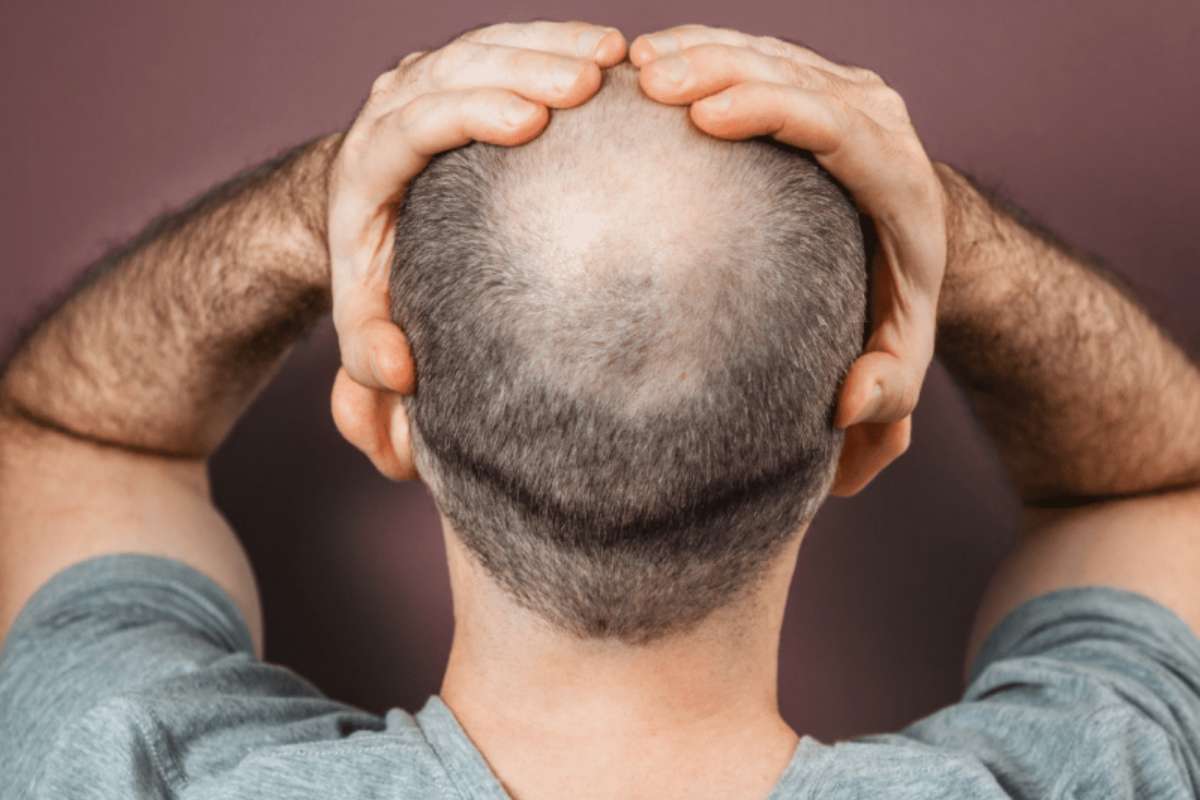Hair loss can be a tough thing to deal with for both men and women. While it is normal to lose some hair each day, and as you begin to age, there are other things that could be causing your hair loss as well. The two most common types of hair loss are diffuse pattern alopecia and unpatterned alopecia. And although they may look similar, they have distinct differences in terms of their causes and their treatments.
Let’s take a look at the differences between diffuse pattern alopecia and diffuse unpatterned alopecia as it pertains to hair loss. We’ll also discuss various treatment options and causes of these two different types of hair loss.
What is Diffuse Pattern Alopecia?
Diffuse pattern alopecia (DPA) is the gradual thinning of the hair across the top scalp in a distinct Norwood 5-6 pattern. This means that rather than having classic receding temples or a circular bald spot on the crown of your head (or both), the hair thinning is spread over a larger area and the scalp becomes more and more visible through the thinning hair as the hair loss progresses. The hair loss is not in specific areas like the temples and the crown. The hairline stays relatively in place but more see-through over time. “Miniaturized hairs” throughout the top of the scalp are the hallmark of this pattern while the donor area maintains its normal thickness and caliber of “terminal hairs.”
This type of alopecia, or hair loss, leaves the posterior and lateral zones fuller. This will allow for a better donor area which means you may be suitable for hair transplant in order to fill in the thinning areas – sometimes.
What is Diffuse Unpatterned Alopecia?
Similar to diffuse pattern alopecia, diffuse unpatterned alopecia (DUPA) does not follow a specific pattern. The hair loss, or thinning, can be noticed across the entire scalp – both in the typical areas of balding on top of the head but also to the sides and back of the head.
Oftentimes this pattern starts out looking like Diffuse Pattern Alopecia (DPA) with the top of the scalp becoming more see-through. But if one examines the scalp closely, there will be miniaturized hairs in the back and sides of the scalp too. DUPA can lead to certain areas of the scalp thinning more than others which may give it a patchy appearance but ultimately the entire scalp is involved. As the thinning progresses, the top, posterior and lateral zones are all thinning so there may be very little difference between the hair loss on the top, back and sides of the scalp.
If DUPA is not recognized, patients may want or be offered a hair transplant. Unfortunately this pattern is NOT a candidate for hair transplant. As described above, DUPA is destined for extensive loss throughout the entire scalp. There is no “donor area” that can be used to harvest strong terminal hairs to replace other miniaturized or receded hairs in another part of the scalp.
What Causes Diffuse Pattern and Unpatterned Alopecia?
Diffuse Pattern Alopecia, like regular Male Pattern Alopecia (Androgenic Alopecia) is largely due to genetics. But, there are factors that can make it worse.
Stress and hormonal changes in your life can also worsen DPA. Physical or emotional stress can lead to the hair follicles entering the resting phase and leading to a noticeable increase in shedding. Changes in your hormone levels due to things like pregnancy, menopause or the use of anabolic steroids can also lead to hair loss.
Outside factors like nutritional deficiencies, medications, or other medical conditions can also cause Diffuse Pattern Alopecia to occur. If your body lacks the necessary nutrients to promote healthy hair growth, like iron and vitamin D, you may start to notice your hair thinning.
Certain medications like anti-depressants and anti-hypertensive drugs can worsen DPA.
With Diffuse Unpatterned Alopecia, the causes aren’t fully understood, but a number of factors are believed to contribute to this type of hair loss along with -once again – GENETICS.
We can never escape our genetics. If someone in your family suffers from severe hair loss, or DUPA, and you notice yourself starting to suffer from it as well, then there’s a good chance it’s in your genes.
Outside factors like nutritional deficiencies and medications are also thought to play a role in diffuse unpatterned alopecia, just as they do with DPA.
Chronic inflammation of the scalp and hormonal imbalances are also thought to be contributing causes of DUPA as they can damage the hair follicles and cause hair loss.
How To Diagnose DPA and DUPA
To diagnose if you’re suffering from diffuse pattern alopecia or diffuse unpatterned alopecia, a doctor will first do a physical examination of your scalp while also looking into your medical history. Blood tests, scalp biopsy and other diagnostic procedures may be needed to better help determine the actual cause of your hair loss.
Based on the results of those diagnostic tests, as well as the physical examination, your doctor will be able to better understand the underlying cause of your hair loss or thinning, as well as if it’s DPA or DUPA based on the pattern, or lack of pattern, in the hair loss. A dermoscopic examination (a special tool used to examine the hair and skin closely under polarized light) is essential for a complete physical exam of the scalp.
Once the doctor is able to determine the cause of the hair loss, they will be able to provide you with a treatment plan to best suit your individual needs.
Treating Diffuse Pattern Alopecia and Diffuse Unpatterned Alopecia
Treating diffuse pattern alopecia typically requires the use of medications, hair loss therapies like laser or PRP or possibly hair transplant surgery depending on the severity of the thinning. It is important to understand that patients with DPA will eventually progress to a Norwood 5-6 which is baldness effecting the top of the head. So no matter how good your donor hair is, there is NEVER enough to replace the entire top of the head that is thinning. Therefore, if you are a candidate for transplant, generally your surgeon will recommend focusing on the frontal zone for the best esthetic outcome.
Minoxidil and finasteride may be used to help slow the hair loss to prevent it from getting worse, faster, and very likely will help some of your miniaturized hair follicles to grow back towards their full or “terminal” strength. A hair transplant may be helpful to take donor hair from the sides and back of your scalp to help rebuild the front of your hair where the thinning is occurring.
Diffuse unpatterned alopecia treatments are much the same, such as minoxidil or finasteride in order to slow down the process of hair loss. You will also want to treat any other underlying causes of the hair thinning. If the hair is thinning due to medication, then stopping the medication or switching to a different brand may help reduce the thinning of your hair and help it return to normal. Similarly, if a hormone imbalance is suspected then hormone replacement therapies may be suggested to help with the hair thinning.
Unfortunately, men (and women) with this pattern are sadly destined for the most baldness – Norwood pattern 7+. Therefore, patients with DUPA should NEVER get a hair transplant. If the hair in the donor area is just as weak as the hair on the top of the scalp, then the procedure is doomed for failure. Understanding the realistic expectations early on is important in order to avoid a costly mistake, like a hair transplant. You can discuss with your doctor options such as hair pieces, wigs and scalp prosthetics that can provide a natural and beautiful camouflage.
Diffuse Alopecia
Whether you’re suffering from diffuse pattern alopecia or diffuse unpatterned alopecia, the first thing you’ll want to do is visit a doctor. Your doctor will be able to help you pinpoint the cause of the hair loss and then help develop a treatment plan that best suits your needs.
There can be many underlying causes of hair loss and it’s best to determine those causes before resorting to a treatment that may not work. In some cases the hair thinning may be genetic, in which case there’s not much that can be done in terms of reversing the hair loss, so a transplant may be possible. If it’s determined that an outside factor is contributing to the hair thinning, then there may be other options available.
If you’re looking for help with DPA or DUPA hair loss, contact us today at the Limmer Hair Transplant Center in San Antonio, TX. We will be happy to setup a consultation to talk through the issues you’re having and help you devise a treatment plan.







